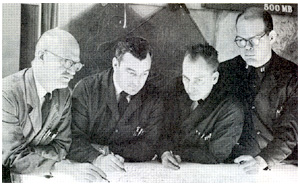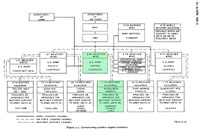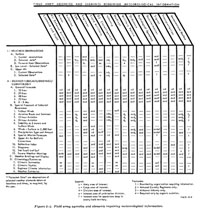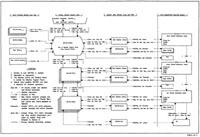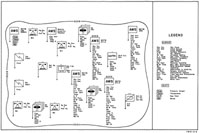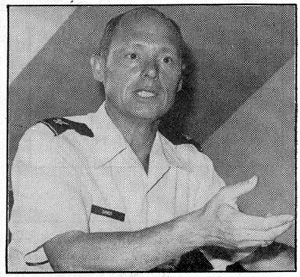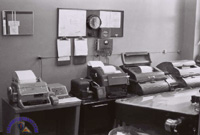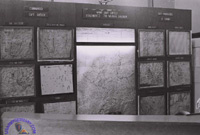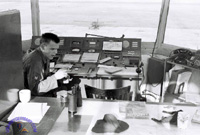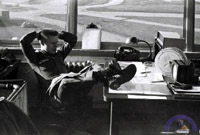| If you do
NOT see the Table of Contents frame to the left of this page, then
Click here to open 'USArmyGermany' frameset |
|||||||||||||
|
7th
Weather Squadron |
|||||||||||||
|
|
|||||||||||||
|
|||||||||||||
|
|
|||||||||||||
| 7th WS History | |||||||||||||
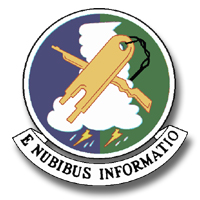 7th Weather Sq emblem 7th Weather Sq emblem |
|||||||||||||
(Source: Army in Europe Magazine, Oct 1965, via Robert Grembos, NCOIC, Soldiers Chorus) |
|||||||||||||
Watchers of the Skies USAREUR's Weathermen . . . the Air Force's 7th Weather Squadron Will the ground at Grafenwöhr be hard enough to take an M60 tank? How will the direction and speed of winds affect an airdrop in Bavaria tomorrow? Would radioactive fallout over Kaiserslautern affect troops at Baumholder? The Army has to have the answers to questions like these, and responsibility for providing them rests with the Air Force's Air Weather Service. What a ground commander wants to know about the weather is different from what the Air Force commander wants to know, and two weather squadrons have been set up to service the Army; the 16th services the Continental Army Command, and USAREUR is serviced by the 7th Weather Squadron. Weather is just as critical to the Army as to the Air Force. Tank and personnel carrier operations are as dependent on it as jet aircraft flights. There's also the fact that the Air Force usually operates from hardened bases, whereas the Army operates on all kinds of terrain. And whether infantry troops will begin operations slogging through ankle-deep mud or not often depends on the accuracy of Air Weather forecasting. |
|||||||||||||
|
|||||||||||||
This integration of the Army and Air Force in the field of meteorology has saved millions of defense dollars. The 7th Weather Squadron is by no means working alone in providing weather information to USAREUR. The big weather picture for the European area comes out of Air Weather Central in London. A Tactical Center near Ramstein, Germany, provides USAREUR (as well as the 17th Air Force) with more detailed information. And, finally, there are the 7th's own 27 subordinate units. This entire network is in constant intercommunication. Air Weather units at lower levels continually get the bigger picture from higher levels and interpret it for their own purposes. They also gather local information at least hourly and feed it back up the line. |
|||||||||||||
|
|||||||||||||
Cloud height: by means of a light beam. Visibility: by checking to see whether objects at known distances can be seen. (Only when visibility is very poor is a more complex photoelectric cell method used.) Humidity, barometric pressure, wind velocity and direction-and, of course, temperature. An expert can put these together and derive an amazing amount of knowledge from the total picture. Weather satellites are gradually making their presence felt too. They can photograph huge cloud areas and provide information that more traditional means cannot. Someday the weather satellite may be king of the field. But today the monarch is still the weather airman who takes his observations and the weather forecaster who interprets them and fits the pieces of the puzzle together. Air Weather Service is pretty proud of its personnel. All the men of the 7th Weather Squadron have at least a high school education. Over half have some college. An Air Weather officer will have a B.S. degree and then will attend an Air Force School. After that he serves a year's "apprenticeship." And any Air Weather man will tell you that school training alone doesn't fill the bill. A man has got to work on the job, get the feel of it, over a period of years. The Army is fortunate to have the services of men of this caliber. USAREUR is particularly fortunate to have the support of a top-notch outfit like the 7th Weather Squadron. Joke about his predicitions if you want, but when the chips are down, the Air Force weatherman is a pretty good man to have on your side. |
|||||||||||||
(Source: FM 31-3 Weather Support for Field Army Tactical Operations, Dec 1969) |
|||||||||||||
(Source: Heidelberg Herald-Post, Aug. 14, 1985) |
|||||||||||||
A look at the folks who bring us the weather. By Shaun Gearon "You don't need a weatherman to tell which way the wind blows," Bob Dylan once sang. But the medevac pilot facing an emergency flight at night through fog and ice needs accurate weather information. So does the corps commander planning an exercise that will take his tanks over German fields. Knowing exactly what the weather will do is important to a wide variety of people in the Army, from the general in his bunker to the soldier in his foxhole. The Air Force's 7th Weather Squadron provides the U.S. Army, Europe with that knowledge. "We provide the army with its metereological reports and forecasts," says Air Force Col. James Sands, who recently assumed command of the squadron. "We can give an accurate picture of the weather situation in the USAREUR area of interest and almost anywhere in the northern hemisphere. This includes not only the information that will attect Army flyers, but also the information that ground commanders need. We don't give the commanders soil conditions, but the information we feed his engineers enables them to predict how it will affect the cross-country movement of his vehicles;' says Sands |
|||||||||||||
|
|||||||||||||
"The job of a weather forecaster is one of the most skilled in the Air Force. It takes an enlisted airman, on average, at least four years working as a weather observer to qualify as a forecaster. Only entrants with high aptitude scores can enlist for these specialities." As Sands talks you can hear the continuous click of teleprinters in the background spewing out reams of information from the central processing point in Traban-Trarbach. Television monitors display a constant stream of data beamed in directly from the European weather satellite METEOSAT. The room is covered with charts and maps showing the development of fronts, low and high systems, from the Azores to the Urals. Sands points to a small cluster of bright white dots on the satellite picture, "Here you can see heavy thunderstorms in the Pyrenees." Then moving his hand up to Germany he points to a cold front that is moving to the east, he explains: "the rain and humidity should clear up and we can expect sunshine in a couple of days." One of the areas that the staff at the 7th Weather Squadron is trying to improve is tactical communications. "At present much of the data that come into the headquarters is turned into pictures and maps by hand. We're still using templates and overlays essentially techniques that date back to World War II. We are in the process of getting the computers that will enable us to collate and evaluate all this information more rapidly, giving us better forecasts," says Sands. Just a few miles away at the Heidelberg Army Airfield, another part of the 7th Weather Squadron, Detachment 3, is at work providing flight operations information to the many pilots who use the field. "The detachment is manned 24-hours a day," says Senior Airman Bill Trowman. "The peak traffic time is 5 a.m. to 2 p.m., when two forecasters and an observer are on duty. A lot of the work is with medevac flights that need flight operations information when other detachments are are closed down. A medevac going, say, from Hanau to Landstuhl late at night would call into Heidelberg to get its weather information." How accurate can you be when forecasting something as fickle as the weather? Col Sands smiles and says: "On the whole we're pretty accurate. Of course there are occasions when we make mistakes." "Weather prediction will always contain a degree of uncertainty. Some old wive's tales have been replaced by scientific myths. For example, `What causes changes in the climate?' "There is an established correlation between changes in the El Nino current in the Pacific and the weather. A combination of atmospheric condition and ocean currents causes a warm current, called El Nino, to dip down from the equator to the normally cold waters off the coast of Peru. This produces changes in the climate. It has caused droughts in Australia and India, severe flooding in Peru and Ecuador, and storms on the Pacific coast, Louisiana and Florida. El Nino also killed off vast amounts of plankton and anchovies, which in turn attracted tuna and sharks. This much is fact. But I have heard one expert claim that the solution to meteorology in the Pacific area is to monitor the movement of tuna and hammerhead sharks." Sands' smile breaks into a broad grin. The Headquarters 7th Weather Squadron is located in 4th Allied Tactical Air Force building on Campbell Barracks and is aligned under the Deputy Chief of Staff for Intelligence. |
|||||||||||||
LIST OF DETACHMENTS OL-B, Det 5, 7th WS - Bamberg AAF (1981) |
|||||||||||||
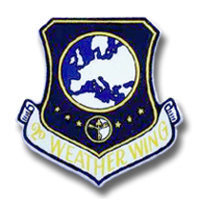 2nd Weather Wing Patch 2nd Weather Wing Patch |
|||||||||||||
| If you have more information on the history or organization of the 7th Weather Sq or other Air Force units that provided direct support to USAREUR, please contact me. | |||||||||||||
|
|
|||||||||||||
| Detachments | |||||||||||||
| Detachment 2, Hanau | |||||||||||||
| 1964 | |||||||||||||
| (Source: Email from Charles Walker, Det 2 , 7th WS, 1964-67) | |||||||||||||
I was in Det 2, 7th WS (Hanau) from Oct. 1964 to Nov. 67. The picture that you show on this web site of Lt Jerel D. Cathey looks just like I remember a Lt. Cathey who was in our unit during that period. Could the picture be that old?
Our commander was Capt. Quelch and the Duty Forcaster was Lt. Cathey who is pictured on your web page.
Do you know of any web sites that might help me find other members of Det 2? |
|||||||||||||
|
|||||||||||||
| 1966 | |||||||||||||
| (Source: STARS & STRIPES, April 3, 1966) | |||||||||||||
| Det 2, 7th Weather Sq, located at the Army airfield on Fliegerhorst Kaserne, Hanau, is commanded by Air Force Maj William H. Quelch, Jr. Maj Quelch also serves as the Staff Weather Officer for 3rd Armd Div. (The Squadron commander, Col Lewis A. Pitt, Heidelberg, serves as the Staff Weather Officer at HQ USAREUR.) The detachment's mission is to provide weather forecasting and observation services to V Corps Hq, 3rd Armd Div, and other USAREUR units in the Hanau area and to support the Air Weather Service's world-wide mission. The detachment's staff is comprised of: Maj Quelch with four forecasters (Capt Robert W. Gossett, Jr. - chief forecaster; 1st Lt Jerel D. Cathey; T/Sgt Walter A. Longstreth; S/Sgt George E. Rice); nine observers (M/Sgt. Joseph P. Wade, chief observer); and two weather equipment technicians (Airman 1.C. James K. O'Hare; Airman 2.C. William W. Best). The detachment also has observing sub-dets at Fulda AAF and at Bonames AAF in Frankfurt. The major flying unit at Hanau is the 503rd Aviation Bn, commanded by Lt Col Leland F. Wilhelm, who also serves as the 3rd Armd Div's aviation officer. The Air Force Weather Station at Fliegerhorst has received new meteorological equipment (valued at $30,000) which was recently installed by a team from the 2874th Ground Electronics Engineering & Installation Agency (GEEIA) Sq at Ramstein. This makes Fliegerhorst only the second Army airfield in Europe to have received this equipment. (The first installation occurred at Heidelberg AAF.) The three new pieces of equipment are located at the end of the runway and consist of a wind indicator, rotating beam ceilometer, and transmissiometer. The ceilometer operates with a rotating beam that bounces off of cloud cover. A receiver determines the height (of the clouds) by reporting the beam angle. This method replaces the old balloon system. The transmissometer also functions with a beam and receiver to accurately measure visibility, complementing visual readings. |
|||||||||||||
| 1976 | |||||||||||||
| (Source: Email from Jeff Muller) | |||||||||||||
| I was stationed in Hanau at Det 2, 7th Weather Sq in 1976-78 as an observer. was wondering if you have anymore information or photos from that time. The Army used Air Force for meteorological work. I was a weather observer working with weather forecasters. I worked in the tower with the air traffic controllers when I was observing weather, and downstairs when I was assisting forecasters. In the detachment, there were about 8 airman weather observers, plus maybe 3 sergeants forecasters and about six officers, the highest ranking being a major. We went of field training exercises and had three Army sergeants assigned to us. Not sure how they worked that with the Army. They all lived off base except for me. I liked it better in the barracks and all my friends were there. As I remember it, I lived in building 1325 at first. In 1976 it was the 62nd Aviation which was later renamed to something else. The small building to the left of that was a quonset hut for supplies. Later I moved to #1326, where I was the only Air Force person living there. 1364 was a community area where guys played games. I think the building to the right was the mess hall. |
|||||||||||||
| Detachment 4, Schwäbisch Hall | |||||||||||||
| (Source: Heilbronn Eagle, February 1983) | |||||||||||||
| Weather predictors keep pilots aloft By Mike Novogradac The Air Weather Service was established in 1937 as part of the Army Air Corps. Previously, Army weather had been a Signal Corps function. After the Air Force was created in 1947, the service took over the responsibility of providing the Army's, as well as its own, weather information service. The Air Weather Service celebrated its 50th anniversary July 1. SCHWAEBISCH HALL - Before aviators with the 11lth Aviation Group climb into their helicopter cockpits and begin a flying mission, there's one very important preflight stop that must be made - a check with weather forecasters of the Air Force's Detachment 4, 7th Weather Squadron. One of the detachment's main missions is to monitor weather and issue weather forecasts and advisories to 11th Aviation Group aviators. Another mission, but certainly not a lesser one, is protecting the Group's resources - in other words, warning Dolan Barracks and its aviators of approaching severe weather conditions. "Basically, pilots would be flying blind without us," said Tech. Sgt. Jerry L. Sanders, noncommissioned officer-in-charge of Detachment 4's weather team. "The topography in Germany makes it so that in one valley, weather can be great and in the next, there can be rain or fog, which can put a cramp in their flying activities." Each section of Detachment 4 has a key responsibility in the weather forecasting process. The observation section actually records the weather as it is happening. One observer actually sits in the top of Dolan Barracks' air traffic control tower and constantly watches the weather. Wind instruments, barometers and glancing out at the horizon to determine visibility are all simple aspects of the big weather picture. A satellite dish which receives a picture from above the Earth, however, is one of the more complicated aspects of predicting tomorrow's weather. "The observers record the type, number and height of clouds, visibility and any obstructions such as rain or fog, temperature, the amount of moisture in the air, wind speed and its direction and barometer pressure readings," Sanders explained. "Then, all of this information is supplied to our forecasters who, in turn, supply their forecast to the airfield, plus transmit it over a teletype for anyone in the world to receive weather information about Dolan Barracks." Once the detachment's forecasters have generated their local forecasts, Dolan Barracks' flying units, base operations and air traffic control tower can contact the detachment for an up-to-date forecast at any time. "Once every hour, we take a record observation and note any significant changes in the weather," Sanders said. "If there has been a change in the weather, this is called a `special observation' and it also is reported to the people who need to know. "Then, it's up to the aviators to decide what they want to do. Our forecasts either keep them flying, or keep them on the ground." |
|||||||||||||
| Detachment 5, Katterbach (Ansbach) | |||||||||||||
| (Source: Ansbach Community Bridge, January 19, 1983) | |||||||||||||
Weather station busy preparing reports for all |
|||||||||||||
| (Source: Ansbach Community Bridge, November 17, 1982) | |||||||||||||
| Repair team keeps weather equipment current By Charlane Busse "There's certainly a lot more to meteorological equipment repair than fixing thermometers," chuckled Air Force Staff Sgt. Nick Baranov, a team chief and repairman for the 1945 Communications Group stationed at Katterbach. Baranov and his six Air Force traveling maintenance teammates run the largest meteorological equipment repair and maintenance operation in Germany. The unit is stationed at Katterbach because it has the only radar equipment in Bavaria and is considered the prime meteorological equipment in Bavaria. Although the teams don't forecast the weather, there would be no scientific weather forecast without the met repair team. Forecasting is done by the Air Weather Service people who inhabit the office next to met repair. "Weather data isn't just important, it's a necessity. It's vital for safety and so commanders can plan activities and operations. It's also nice to know whether you should plan a picnic or get out your skis," said Air Force Tech. Sgt. Mark Hamberger, chief, weather station operations at Katterbach. "This is one of the busiest heliports in USAREUR and for us, weather data is mandatory for safety. We depend on our repair service and they haven't let us down;" said Hamberger. In fact, during a recent Air Force inspection, the Katterbach operation was commended for being the best maintained in all of Europe;' Hamberger added with satisfaction. Met repair is a demanding job, servicing everything from radar equipment to the simplest portable gear like a thermometer. Two member teams tend 14 sites repairing, and performing routine and preventive maintenance on a circuit that would tire any traveling salesman. The route includes Grafenwoehr to the west, Wertheim to the east, Bamberg to the north and Nellingen in the south, totaling more than 5,000 miles traveled a month. This sort of work isn't for everyone and takes an unusual mix of talents - not only brains but a high degree of manual dexterity. It calls for a delicate touch, the patience of Job and the quirk of being a borderline perfectionist. There is no margin for error and no "tolerance factor." "Good enough for government work just won't get it in this repair shop," said Baranov. These specialists have to be perfectionists not only in repairing the equipment but also in keeping track of where every piece of gear is and in what condition it's in, which can sometimes be tricky when units have to mix and match gear. Sensitive equipment won't take a swift kicking and still keep on ticking, with apologies to John Cameron Swazey. But occasionally a strong back is nice, especially when the repairman has to say, "Can't fix that here. I'll have to take it to the shop." Of course they never leave a site lacking equipment and carry spares for many items on their rounds. The job takes an inquiring mind because learning isn't over after these specialists complete their initial eight months training. "You have to stay on top of the changes. The field is getting more technical and sophisticated all the time. Then every once in a while, you get some gear that no one has seen before. That's the time you have to do some reading and research," said Baranov with a glance toward the ceiling-to-floor shelves holding reference material. Although the met repairmen can't control the weather, the weather report won't keep them from making their rounds -- neither rain, nor snow, nor . . . |
|||||||||||||
| Detachment 7, Grafenwöhr | |||||||||||||
| (Source: TRAINING TIMES, February 1983) | |||||||||||||
| Air Force provides weather info; aids GTA with daily predictions by Bob Shipp Have you ever noticed Air Force personnel walking around post and wondered where they were from? Some of them are assigned to Detachment 7, 7th Weather Squadron right here in Graf. The detachment's primary mission is to provide forecast and observation support to the Graf airfield. They also support Range Operations with temperature and wind data and provide TDY personnel to augment other 7th Weather Squadron units on field exercises. "When training units bring their helicopters here, they don't bring any weather people with them about 90 percent of the time so we must support them also," says Detachment Chief Senior Master Sergeant Thomas L. Cantwell. Forecasters normally work from 6 a.m. until 5 p.m., depending on airfield hours. But observers are on-site 24-hours-a-day, seven-days-a-week, mainly to support 15th Med in any Medevac missions. "The workload for observers is fairly continuous except during bad weather," remarks Cantwell. "As the weather gets worse more observations are required because of changes in visibility, ceiling and such. They normally take observations every hour but bad weather conditions can mean as many as eight an hour. "Observers like to see good weather," he says, laughing. The detachment has some exotic sounding equipment as well as the same plain instruments we all have at home. "We have a Rotating Beam Ceilometer which is a revolving projector that emits an infrared beam into the sky," explains Cantwell. "When this beam hits the clouds it bounces back down into a detector. We can then determine the cloud base height. "We have a wind vane near the runway and a readout that gives us a continuous record of the wind as well as two meters that give instantaneous wind direction and speed. "There is a light meter aligned with the runway which measures visibility; how far down the runway you can see. It isn't needed much for helicopters but is important for fixed wing aircraft." The weather station has two barometers to measure air pressure, a mercurial barometer, which every weather station has and an aneroid barometer. "A reading is taken every half hour from the aneroid barometer and aircraft set their altimeters by these readings," says Cantwell. "Our rain gauge is a six-inch cylinder with a two inch tube inside and we have a wet bulb and dry bulb thermometer." The detachment also puts out a 24 hour forecast three times a day. Anyone can get the day's forecast simply by dialing 6159. "I've enjoyed my time here," states Cantwell. "It's definitely a different type of situation here than any of the other jobs I've had. I'm looking forward to the next 18 months." |
|||||||||||||
| Detachment 10, Giebelstadt | |||||||||||||
| (Source: FRONTLINE, February 22, 1985) | |||||||||||||
| Article by T.L. Barton Many battles throughout history have been decided, not by the might of brute force, but by the uncertainly of the elements. Napoleon and Hitler lost thousands of troops to the terrible Russian winters. Wellington crushed the mighty Spanish Armada with the help of a freak gale. And today, in the day of space age technology, with dozens of weather satellites circling the globe, the elements continue to prove "who's in control." During field exercises commanders need to know what type of weather might confront them. It would be a little embarassing to create a smoke screen to cover a strategic withdrawal just to have it blow away in a few seconds. The 3rd Infantry Division has its own weathermen. Detachment 10, 7th Weather Squadron, homebased in Giebelstadt, with weather observers in Wertheim and Kitzingen, are the "eyes on the sky" for the division. Commanded by Capt. Thomas N. Talbot, the 20 Air Force airmen and officers of Detachment 10 keep a roundthe-clock watch on developing weather conditions and trends. "Our primary mission is to support the 3rd Infantry Division when they go to the field," Talbot said. "But we also provide weather forcasting and warnings for pilots in the division, working through G-2." Talbot said the detachment in Giebelstadt supports the flyers of 4th Brigade by providing pre-flight briefings, while the airmen stationed in Kitzingen and Wertheim do just weather observation at airfield control towers. Finding out what the weather will be like isn't as simple as listening to how fast frogs croak. Airman 1st Class Kenneth D. Peirce, weather observer, stationed in Wertheim, said he uses a pressure wheel, thermometers, a wind directional gauge and a telex machine to keep on top of the weather outlook. "We also report on the luminosity of the moon. Depending on the time of year, amount of cloud cover and fog, we can tell how much light will be given off," Peirce said. "This is important for night time battles." Another important aspect of the weather observers work is visibility conditions for pilots. Sr. Airman Hoover E. Hodge, senior weather observer at Kitzingen, said he can tell what the visibility is at I 0 feet above the runway and what the cloud level is. "There is a light that reflects on a mirror and is then bounced to a receiver. The receiver knows how much light is being sent and it is just a simple job of finding out how much light is lost in the intermediate distance. "Finding out the cloud ceiling is along the same lines. An infrared light is beamed skyward and another receiver picks up the reflection. Since the angle and distance between source and receiver are known, it's just simple math," he explained. Also important to the pilots of helicopters is wind speed, Hodge said. "If the wind is too strong, the 'copters aren't allowed in the air." Although they wear Marne patches, and consider themselves Marnemen, they fall under the command of the 7th Weather Squadron in Heidelberg. Being in the Air Force and working for the Army isn't new to the three, but Talbot said he still finds it challenging. "One of the biggest challenges is getting support from the Army. All the equipment we use, except the weather forecasting devices, is from the Army. "Another is adjusting to the way the Army does its paperwork and the relationships between the officers. The Army seems to be more formal," he said. Talbot worked with the Navy in the states also. Hodge said the Army is more mission oriented, unlike the Air Force which he feels is more people oriented, and both airmen agree that the physical training is more demanding. Editor's note - Detachment 10 will be providing Frontline with consistent monthly forecasts and interesting weather facts and phenomena. |
|||||||||||||
| Detachment 11, Mannheim-Sandhofen | |||||||||||||
| See article on Coleman Army Airfield Page. | |||||||||||||
| Detachment 12, Mainz-Finthen | |||||||||||||
| See article on Finthen Army Airfield Page. | |||||||||||||
| Detachment 14, Heidelberg | |||||||||||||
| (Source: Heidelberg Herald-Post, July 20, 1984) | |||||||||||||
| Tactical Forecast Unit deactivates Detachment 14, 7th Weather Squadron, the US Army Europe Tactical Forecast Unit, deactivated on July 1 and Detachment 13, 7th Weather Squadron, the USAREUR Forecast Unit, assumed Detachment 14's mission. Detachment 13 is located at Traben-Trabach, West Germany, about 12 miles from Hahn Air Base. Weather support to Headquarters USAREUR is now being provided by 7th Weather Squadron Headquarters located at Campbell Barracks, HM 7134 or HM 8316. |
|||||||||||||
| Related Links: |
|||||||||||||


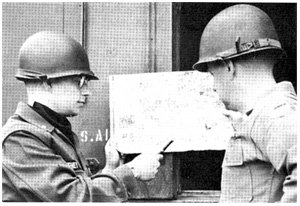
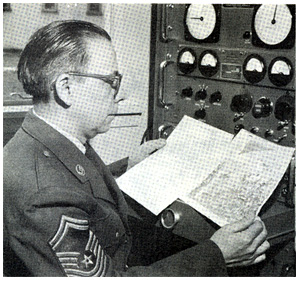 CMSgt Raymond G. Roberts examines a cloud photo.
CMSgt Raymond G. Roberts examines a cloud photo. 